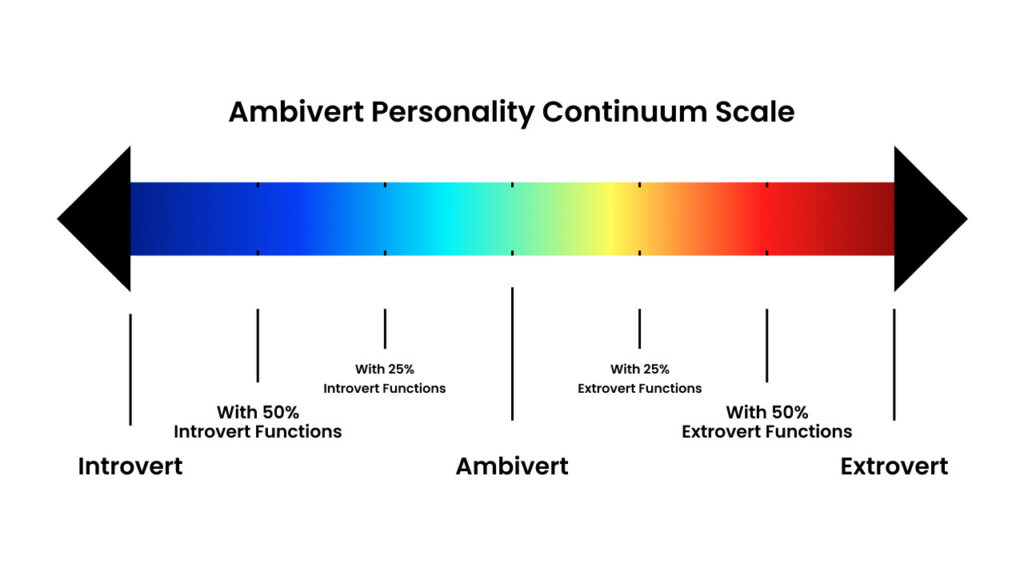
I’m pretty sure that you’ve been asked several times if you’re an introvert or an extrovert. What do you categorize yourself as? Do you enjoy being alone or in social gatherings? Do you prefer talking to people or just listening to them?
If you have a mix of these traits, you could be an ambivert. In general, an ambivert is a person with a balanced extrovert-introvert personality.
A recent study by Adam Grant, a psychology professor at The Wharton School, University of Pennsylvania, has shown that two-thirds of the global population are Ambiverts, who have both introverted and extroverted traits.
While extroverts are known for their talkative nature and introverts for their silent behaviors, ambiverts fall in between, exhibiting both introverted and extroverted traits.
But how can you tell if you’re really an ambivert? What are the signs that you are an ambivert?
Continue reading to know what an ambivert person looks like and explore the common signs that determine if you are an ambivert.
What is an Ambivert?

Let’s start by understanding the concepts of introvert and extrovert.
An extrovert is a person who finds their energy from being around other people. Extroverts enjoy being out and about, attending social gatherings, and interacting with others. They are often known as ” people persons.”
An introvert, on the other hand, gets their energy from calm reflection. They prefer to spend time alone or with one or two people to whom they are close. After being in a group social setting, they usually need some “alone time” to recharge.
Ambivert meaning:
The term ambiversion was coined by famous psychologist Kimball Young.
He believed that everyone has both introverted and extroverted traits and that everyone falls on a spectrum.
Let’s dig into the term “Ambivert” itself to further understand its meaning.
Ambiversion is denoted by the prefix ‘Ambi-.’ This comes from the Latin words ‘ambo’ and ‘ambae,’ which represent “two of a pair, both.”
Did you find it relatable?
Yes, this proves that ambiverts are “both” in the sense that they balance introverted and extroverted personality traits.
13 Signs That You May Be An Ambivert
If you think you might be an ambivert but are not quite sure, it’s time to test yourself using common signs. If the below qualities are relevant to you, you’re most likely an ambivert.
1. You are an active listener plus communicator
We all know how talkative extroverts are. On the flip side, introverted people are silent observers. You see, extroverts love to talk more, and introverts tend to observe and listen.
But ambiverts possess this unique ability – They know when to listen and when to speak up. They end up diverting the conversation to them in an interesting way.
2. You prefer to work independently but also with a group
Ambiverts usually prefer a mix of individual and group projects or presentations. You believe you can complete tasks on your own as a self-starter when necessary.
At the same time, you value the input of working with a team and recognize the collective efforts involved in problem-solving.
3. You have different kinds of friends
Unlike extroverts, ambiverts do not feel the need to make hundreds of friends. You prefer to have more intense relationships and conversations. You have a small circle of friends who genuinely care about each other.
After all, quantity over quality.
Moreover, what’s interesting is that you have all kinds of friends in your circle. They’re a mix of introverts and extroverts, with some ambiverts thrown in for a little spice. You interact with them depending on the social situation.
But hold on. There’s more.
Just because they have a small circle doesn’t mean that you aren’t fond of meeting new people. In fact, ambiverts find it exciting and refreshing to meet new people, especially when people are different but give off similar vibes.
4. You mean different to different people
Your mom might think you are shy and introverted, while your best friend may see you as an extrovert. Both perspectives are valid. Each person you meet creates an image of you in their mind, possibly labeling you differently.
The question is: How do you know which is the real you?
This could be a clear sign of your ambivert nature. If the people you know regard you as both, either because you play different roles in different settings or because your approach is inconsistent, you are not at either end of the spectrum.
5. You’re comfortable in different social situations
Ambiverts like meeting new people, but not always. In fact, they are fun people to be around.
As an ambivert, you can easily adjust your behavior to fit different social situations you are in, whether that means being quiet in face-to-face conversation or taking on a leadership role in a larger group.
Regardless of personal preferences, you do not feel alienated or uncomfortable in different circumstances. You can easily handle different social situations, showing adaptability and comfort in various scenarios.
6. You’re adaptable
Depending on the situation, ambiverts change and adapt themselves to meet their needs, oftentimes to their advantage. That means you can adapt yourself to any social situation just like a chameleon.
Let’s say that in a team meeting, your manager asks who should take the lead position for the project. Suddenly, you come forward and confidently lead the way. You don’t think twice before making a decision.
When your coworkers think they have you figured out as the boss, you surprise them by standing aside and easily switching into a supportive role, letting others take the spotlight. This shows you’re incredibly adaptive and a good team player.
You are lucky that you have the gift of effortlessly fitting in anywhere!
7. You can do both small talk and deep talk
Ambiverts know the importance of small talk and casual conversations and the value they bring.
At the same time, they enjoy exploring new topics and having deep conversations with familiar people. It all depends on the mood.
8. You’re empathetic
For ambiverts, empathy comes naturally to them.
They empathize with others easily. When they talk and you listen, you can find out what they are feeling. As a result, you may respond in a friendly manner to other people.
In contrast to introverts, who must train and pay attention to become good at it, extroverts are capable of using empathy rather naturally. It seems like you might behave more like an extrovert because you don’t really need to practice it. You’re already capable of feeling other people’s emotions.
Imagine a scenario in a lift full of strangers. An extrovert might initiate small talk, but an introvert might put in earbuds or use a phone to avoid interaction.
So, what will you do as an ambivert?
Your response may lean toward either choice depending on the social context of the people present.
9. You have multiple interests and hobbies
Just like introverts, you love to read books, take long walks, meditate, chill, watch movies, wear unique jewelry types, and enjoy solitude. Contrarily, like extroverts, you like to play carrom or sports with a group or live to party in a club.
Since you have a balanced personality, you enjoy a mixture of interests, which include both social and solitary pursuits. That means you get the best of both worlds.
10. You need sometimes to be alone after intense socializing
This is something all of us can relate to.
If you find yourself socializing more often, over-expressing your emotions, and being too extroverted for long, you may feel burnt out.
At this point, being an extrovert becomes a stressful and demanding role you’re playing.
On the other hand, if you find yourself in too much solitude without engaging with other people, then you may become bored and depressed.
11. You are indecisive and unpredictable
Should I go out with my friends for lunch or stay in a cozy bed watching FRIENDS show? Should I attend my cousin’s birthday party on the weekend or rather sleep at home?
This is called indecisiveness.
You see, since we, as ambiverts, are both introverted and extroverted, sometimes we get confused and don’t understand what exactly we’re looking for at the time. Sometimes, ambiverts may experience spiraling thoughts.
There are moments when you will feel like you want to be alone by yourself, and then 20 minutes later, you end up feeling sad and yearning for the company of a friend or a close one.
Contrarily, there are times you might feel the urge to go out and socialize, only to feel lonely and isolated when you find yourself in a crowd of cheerful people.
It’s like getting stuck in situations that don’t quite match your current mood.
12. You have love-hate relationships with social media
This is the most exasperating part of being an ambivert. Often, you keep going on and off social media.
A part of you wants to be active on social media, stay in touch with people and followers, and seek stimulation, while the other part of you wants alone time and is indifferent to social media, aka anti-social.
This internal tug-of-war shows the complex relationship ambiverts often have with the digital world.
13. You can be both shy and confident
Extroverts are often confident, creating ahead with their thoughts and welcoming fresh perspectives. On the flip side, introverts tend to be more cautious, analyzing situations before speaking up, and may come off as shy.
However, if you find yourself alternating between both confident and reserved sides, depending on different circumstances, you might be an ambivert.
There’s no clear winner between the two styles for you, as you easily adapt based on how you feel. It’s not that one comes more naturally; various factors influence your flexible approach.
Can You Be An Introvert & An Extrovert?
Yes. You can be both an introvert and an extrovert. That’s what we call an ambivert. Ambiversion contradicts the usual divide by implying that people can have traits from both personality types.
It all depends on your personality and the situation you’re in.
Some days, you might feel like staying alone in your room, staying in your PJs, watching Netflix all night without feeling the need to talk to anyone. On other days, you may feel compelled to go out and party with your friends.
In a general sense, ambiverts have a distinct advantage over introverts and extroverts. Since their personality does not shift too much in either direction, they can adjust their approach to people more easily based on the situation. This allows them to connect more easily and genuinely with people from different walks of life.
If you’re still in a dilemma and want to know if you really are an ambivert, you can take this psychology test now, which was created by Pink, who has studied ambiversion.
What About Omnivert?
The word omni in omnivert simply means “universally” in Latin.
An omnivert usually fluctuates between introverted and extroverted behavior depending on the situation or mood. They have signs of both extroversion and introversion.
However, unlike ambiverts, they do not exist between the two extremes or exhibit both personalities at the same time. Simply put, they jump around on the personality spectrum. This means their personality is entirely situational, unlike ambiverts.
Summing Up
We hope this article gave you an idea about the signs that you may be an ambivert. If these signs apply to you, well, you’re on the right track.
You are someone who falls in the middle of the introversion-extroversion spectrum. Even though it’s perplexing to be an ambivert, the beauty lies in achieving balance. On certain days, we happily embrace social connections and outgoing activities, while on others, we find comfort and pleasure in our own company.
We become emotionally balanced when we learn to accept and understand ourselves. Even if we don’t want to, we can make small talk.
Lastly, we ambiverts have the unique potential to make all types of people feel comfortable with us. Although our personality may initially appear complicated and puzzling, in reality, it is our greatest strength.
FAQs
1. How do I know if I am an ambivert?
Ans: If your personality has both shy and outgoing confident sides, and both show at different times depending on the situation, you could be an ambivert.
2. What are ambiverts’ traits?
Ans: Ambiverts have lots of great traits. They exhibit personality traits of both introvert and extrovert. Some of Ambivert’s traits include alone time, good listening, great communication skills, friendliness, and adaptability.
3. How rare are ambiverts?
Ans: Many people call themselves proud ambiverts. About 60 to 70% of the world’s population are considered ambiverts, according to Cockerill.
4. Are ambiverts bipolar?
Ans: No. Ambiverts are not bipolar. They are just normal people who experience mood swings and are still functional. They are like private people, yet open books. They won’t tell until and unless you don’t ask.
5. Do ambiverts have social anxiety?
Ans: Everyone can have social anxiety, be it an introvert, extrovert, or even an ambivert. However, for ambiverts, it depends on their mood and the situation they are in.
6. Do ambiverts talk a lot?
Ans: No. Ambiverts are great listeners and active communicators. Generally, they don’t talk a lot but talk when necessary, depending on the social situation and the conversation.
Read Also:




